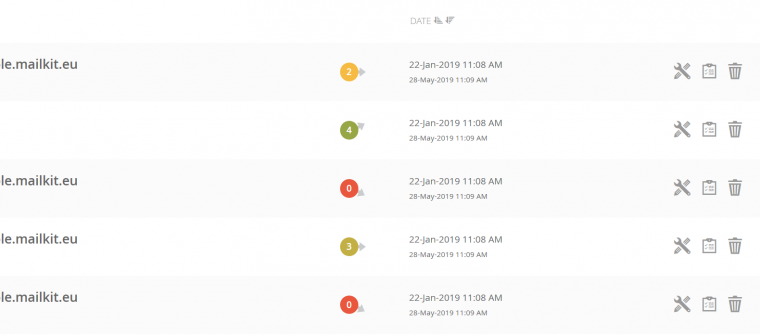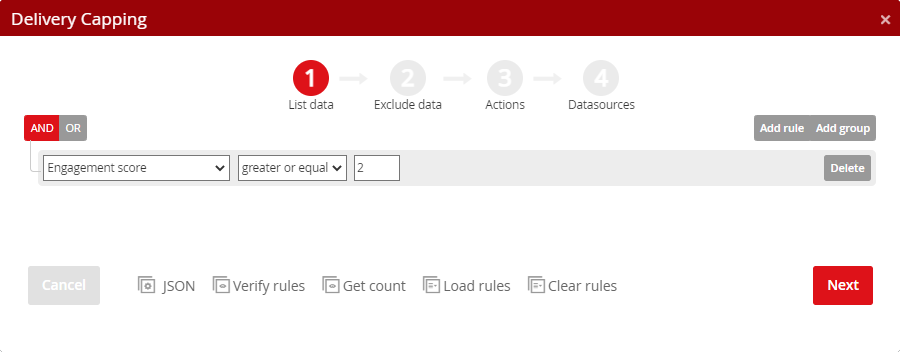How does engagement scoring work?
In short, it is a mathematical calculation of the recipient's quality based on its responses to the email campaigns sent and its behavior. The system automatically evaluates the whole set of criteria:
- Sending messages and their frequency
- Opening and reopening messages
- Clicks and repeated clicks
- Forwarding, printing or sharing messages on social networks
- Displays in the browser
- Conversions
- Message bounces
- Unsubscribes and spam reports
- and many other things ...
From this information, the system then creates an Engagement score evaluation on a scale from 0 to 5 points:
- 0 points –> inactive recipients to whom it was repeatedly not possible to deliver messages or do not respond to any of the sent messages for a long time. This group contains zero or only negligible potential for further communication.
- 1 point –> inactive recipients who do not respond for a long time, or very exceptionally. However, this group still has a chance to reactivate and should be the target of reactivation campaigns.
- 2 points –> recipients with below-average activity, but solid potential for further communication and improvement of engagement through targeted communication in the form of personalized discounted offers and reduction of the frequency of sent messages.
- 3 points –> is the default value for new recipients indicating that it is a completely average recipient with neutral behavior. For these recipients, it is usually easiest to get their attention and increase engagement, especially if they have a neutral or rising trend.
- 4 points –> recipients with an above-average interest in the messages sent, often and positively react to them and are generally the core of the success of the campaign.
- 5 points –> they are the most valuable recipients who respond to almost everything that is sent to them, they like to share these messages (forward, share, etc.) and in the case of e-commerce they often make purchases.

The default value of each recipient is a score of 3 points, which then changes over time as the recipient responds to the messages sent to him. Because the behavior of the recipients changes depending on many factors – the frequency of sent campaigns, the attractiveness of the content, date and time of sending, or eg availability of the recipient over time (holidays, weekends, etc.), the system takes into account all these data and updates scores continuously.
The Engagement score eliminates these fluctuations from the usual behavior of the recipient and provides an accurate picture of his/her interest or lack of interest from a long-term perspective, including monitoring the trends of individual recipients. Simply put – each message sent to the recipient results in a decrease in the engagement and response of the recipient (read, click, conversion) on the contrary results in an increase. The decrease and increase of engagement is also influenced by other factors, such as the frequency of sent messages, previous behavior of the recipient, type of activity, etc. This ensures an objective evaluation of the recipients and the strength of their relationship with the sender.
An important additional parameter for individual scores is the engagement trend, which shows the development of the recipient's behavior. The engagement trend can be:
- rising (2)
- slightly rising (1)
- neutral (0)
- slightly decreasing (-1)
- decreasing (-2)
Why should you use engagement scores?
If you target your campaigns by engagement score or trend → you will send fewer messages but better targeted → you will have a higher percentage of relevant recipients → who will respond positively to your messages → gaining a better reputation → which will ensure better delivery also in other campaigns → and this will lead to greater performance of all your campaigns.
How to use engagement score?
In the campaign delivery capping, you can easily define to which recipients with which engagement score or trend the campaign should be sent.

Typically, campaigns with significant incentives (discounts, promotional items, etc.) should be sent with a low frequency (less than 1 week) to segments with 1 and 2 points and try to reactivate them.
Conversely, recipients with 4 or more engagement points can be sent across campaigns without motivation, or with personalized incentives reflecting their importance, as they are highly loyal customers.
It is also appropriate to take into account the engagement trend. If the recipient has a decreasing trend, it is necessary to adjust the campaigns and increase incentives, or reduce the frequency of sending messages. Utilizing a combination of score and trend can be a powerful tool for reducing frequency and increasing recipient engagement.
The use of segmentation according to engagement has a fundamental influence on the success of campaigns and thus the return on investment in email marketing. Typically, 70-80 % of recipients have low engagement, and are thus primarily a cost, on the contrary, 20-30 % of recipients are the recipients who will bring you business results. However, this doesn't mean that some segments can be ignored and others paid more attention to – this means that these segments require different types of care and investment. With the use of segmentation according to the engagement score, you can not only significantly save on the costs of sending email marketing messages, but also on their preparation. By implementing campaigns well, you will reactivate less active recipients, reverse the decreasing trend, improve their engagement and, last but not least, increase the success of your campaigns.







